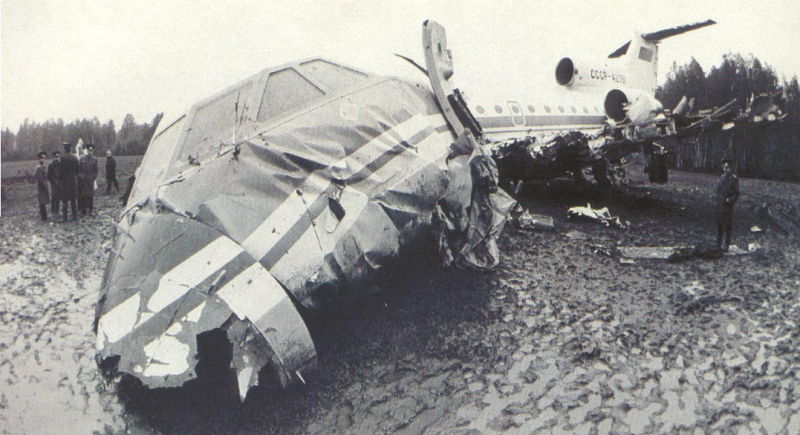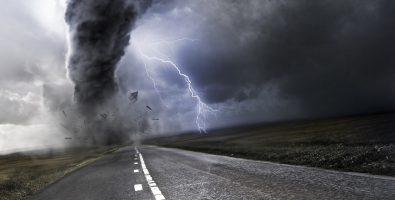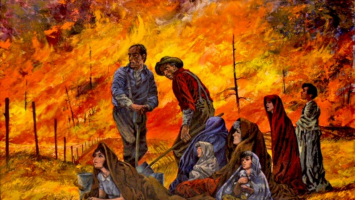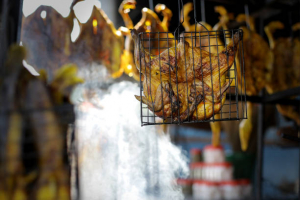Top 12 Historical Disasters that People Tried to Cover Up
There’s a famous episode of The Simpsons in which Bart gets a job as Krusty’s assistant on his TV show and proceeds to destroy the entire set. His immediate ... read more...response is, “I didn’t do it.” Everyone laughs, and it becomes a bit. It’s also a solid example of how people often react to major disasters. Deny it happened, and if possible, make sure no one ever knows it happened. Here is a list of historical disasters that people tried to cover up.
-
When it comes to historical disasters that people tried to cover up, one can't help but mention the Banqiao Dam disaster. A typhoon (tropical cyclone) occurred in August 1975 in western Henan province, China as a result of a typhoon (tropical cyclone). The subsequent floods killed over 150,000 people, making it one of the deadliest typhoon disasters in history.
The Banqiao Dam on the Ru River was built in the early 1950s as part of a flood-prevention and electricity-production program to control the Huang He (Yellow River). It was built to withstand a "1,000-year" flood and stands 387 feet (118 meters) tall with a storage capacity of 17.4 billion cubic feet (492 million cubic meters) (i.e., a flood level expected once every millennium). However, when Typhoon Nina stalled over Henan in early August, it caused floods twice the 1,000-year level. The total precipitation on the first day exceeded 40 inches (1,000 mm), exceeding the area's total annual precipitation by about one-fifth, and three more days of heavy downpours followed.
The dam began to fail shortly after 1:00 a.m. on August 8, resulting in a rush of water up to 33 feet (10 meters) high and 7 miles (11 km) wide in some areas, moving at approximately 30 miles (50 km) per hour. The nearby town of Daowencheng was immediately inundated, killing all 9,600 residents. As a result of the typhoon and the ensuing floods, 61 other dams and reservoirs failed that day, including the second largest dam in the flood-prevention system, the Shimantan Dam on the Hong River. The lack of an early-warning system or an evacuation plan exacerbated the disaster, and according to the official death toll, 26,000 people died in the floods. Furthermore, an estimated 145,000 people died as a result of epidemics (caused by contaminated water) and famine; some estimates put the total death toll at more than 220,000. The disaster claimed the lives of over ten million people.
Following the disaster, Chinese officials conducted a nationwide examination of the country's reservoirs. Chen Xing, a prominent hydrologist whose warnings and criticisms had gone unheeded during the construction of the Banqiao Dam, was called back to assist in clearing the river channels. Many of the 62 dams that were destroyed were rebuilt, including Banqiao (completed in 1993). (1996).
Date: August 1975
Location: Henan, ChinaCause: Typhoon Nina, engineering flaws, policy errors. (Background: Great Leap Forward to the Chinese Cultural Revolution)
Deaths: 26,000 to 240,000
Property damage: 62 dams collapsed; 30 cities and counties (3 million acres) were inundated more than 5 million houses collapsed 10.75 million people affected.
https://www.youtube.com/ https://www.youtube.com/ -
The Sverdlovsk plane crash on January 5, 1950, killed all 19 people on board, including almost the entire Soviet Air Forces ice hockey team (VVS Moscow)—11 players, as well as a team doctor and a masseur. The team was flying in a twin-engined Lisunov Li-2 transport plane, a licensed Soviet-built version of the DC-3, to a game against the Chelyabinsk Dzerzhinets (Traktor Chelyabinsk) hockey club. The flight was diverted to Sverdlovsk due to bad weather in Chelyabinsk. The crew attempted four approaches to Koltsovo Airport in Sverdlovsk, Russian Soviet Federative Socialist Republic, but the aircraft crashed near the airport during the fifth approach in a heavy snowstorm with strong winds.
It has been claimed that Vasiliy Stalin, Josef Stalin's son, was in charge of the team and did not want to upset his father. As a result, he never told him. Rumor has it that the younger Stalin simply formed a new hockey team, and his father, who was never a big fan of the game in the first place, was unconcerned.
It's difficult to confirm whether that part of the story, though widely reported, is true. However, the crash was never mentioned in the state media, and the team was replaced. It's debatable whether this was done with or without Stalin's knowledge.
Date: January 5, 1950
Cause: Landing failure
Site: Koltsovo Airport, Sverdlovsk, USSR.
Operator: Soviet Air Force Transport
Deaths: 19https://www.youtube.com/ 
https://www.baaa-acro.com/ -
The Benton fireworks disaster was an industrial disaster that occurred on a farm near Benton, Tennessee, on May 27, 1983. A powerful explosion at an unlicensed fireworks factory producing illegal fireworks killed eleven people and injured one, revealing the factory's existence to law enforcement as well as the public for the first time. The initial explosion was heard more than 20 miles (32 km) away.
The event received national attention, was covered by major media outlets, and sparked a two-year federal investigation that resulted in the conviction of 21 people, including the factory's owner, a man considered to be the mastermind, and several others from multiple states who conspired to manufacture, transport, and/or allow the fireworks manufactured at the operation to be transported. Investigators discovered the factory to be the largest and most profitable illegal fireworks operation in US history. The disaster was the deadliest event involving illegal fireworks in US history.
Several witnesses claimed to have seen a white Cleveland from more than 20 miles (32 kilometers). Several 911 calls were received shortly after the initial blast, and several police units arrived on the scene within minutes. Linda Sue Webb, who was in the house at the time, fled before deputies arrived. Tommy Webb, who was critically injured, was transported to Erlanger Medical Center in Chattanooga with burns covering approximately 35% of his body. Later, ATF and TBI crews arrived to investigate the cause of the explosion. Later, a Tennessee Emergency Management Agency TEMA crew arrived on the scene to identify the victims, which included forensic anthropologist William M. Bass of the University of Tennessee in Knoxville.
Date: May 27, 1983
Location: 1278 Welcome Valley Road, Benton, Tennessee
Also known as: Polk County fireworks disaster
Cause: Undetermined
Deaths: 11https://www.youtube.com/ https://www.youtube.com/ -
The Burnden Park disaster occurred on March 9, 1946, at the Burnden Park football stadium, then the home of Bolton Wanderers. The crush killed 33 people and injured hundreds of Bolton supporters. Until the Ibrox Park disaster in 1971, it was the deadliest stadium-related disaster in British history. The game, an FA Cup Sixth Round second-leg tie between Bolton Wanderers and Stoke City, was allowed to continue with no goals scored. The disaster prompted the Moelwyn Hughes report, which advocated for stricter crowd control.
The crowd was estimated to number more than 85,000 people. The only way into the ground's Bolton end, which had no roof, was from the Manchester Road end. The disaster occurred at the Railway End of the ground, which, like many other post-war grounds, had rudimentary facilities. The bank was simple, consisting of dirt with odd flagstones for steps. Although there was space on the Burnden side of the ground, the Ministry of Supply had requisitioned a portion of the stand, which had not yet been returned to normal use following the war. Furthermore, the turnstiles adjacent to the Burnden Stand at the east end of the Railway Embankment had been closed since 1940.
Rather than purchasing tickets in advance, fans paid at the turnstiles at the time. As a result, the end became crowded and overcrowded, and the turnstiles were closed at 2:40 p.m. This did not stop more people from entering the ground, with people climbing in from the railway, climbing over the closed turnstiles, and entering through a locked gate when it was opened. Many fans were pushed along the side of the pitch, around the far end, and eventually right out of the ground during the melee, ending up in the car park unable to watch the game.
The crowd began spilling onto the pitch shortly after the game began, and the game was temporarily halted while the pitch was cleared. However, two barriers collapsed at this point, and the crowd fell forward, crushing those beneath. The game was restarted, but it was quickly halted again when a Bolton Borough Police officer came onto the pitch to inform the referee, George Dutton, of a fatality. He then informed the two captains, Bolton's Harry Hubbick and Stoke's Neil Franklin, and the players left the pitch.
The dead and injured were removed from the railway end terrace, with those who died lying along the touchline and wrapped in coats. The game was restarted a little less than half an hour after leaving the pitch, with a new sawdust lined touchline separating the players from the corpses. At the end of the first half, the players switched ends and began the second half. Stanley Matthews, who was on the Stoke team, later expressed his disgust that the game was allowed to continue.
Date: 9 March 1946; 76 years ago
Location: Bolton, Lancashire, England
Cause: Overcrowding of banking terraces causing a stampede
Deaths: 33https://www.youtube.com/ https://www.youtube.com/ -
There's some justice in the fact that the worst rocket accident in history, which happened 50 years ago this week, is remembered by the name of the man who caused it. Marshal Mitrofan Nedelin was a daring military commander who rose through the ranks to command the Soviet Union's Strategic Missile Forces during the Cold War. In the autumn of 1960, his primary focus was the development of the new R-16 intercontinental ballistic missile, which was intended to compete with the American Atlas. Work on the R-16 was ahead of schedule, according to Soviet rocket designer Boris Chertok in his landmark history Rockets and People, with a target date of July 1961 for the first launch, when Nedelin upped the ante: he would launch on November 7, in time for the 43rd anniversary of the Soviet revolution.
Nedelin's quest for glory cost him his life, as well as the lives of nearly 100 other people. Because the schedule was rushed, exhausted workers took all kinds of shortcuts and risks, including continuing to work on the missile after it had been fully fueled on the Baikonur launch pad, with 250 people milling around within close range.
On the evening of October 24, a series of errors, including an incorrectly set switch, resulted in a rocketeer's worst nightmare: the R-16's second stage fired on the pad while still attached to the first stage beneath it, which exploded. There was an investigation, but there was no witch-hunting or official blaming. The Soviet authorities decided that being present at the accident scene was sufficient punishment for the engineers and technicians who survived. Families of the victims were instructed to remain silent, and the first detailed accounts of the accident did not appear until the late 1980s.Marshal Nedelin, on the other hand, was near the base of the missile at the time of the explosion and was killed in the blast. "The majority of the dead were unrecognizable," Chertok writes, "but Nedelin was identified by the 'Gold Star' medal that had survived."
Native name: Катастрофа на космодроме Байконур
English name: The Catastrophe at Baikonur Cosmodrome
Date: October 24, 1960
Time: 18:45Type: Rocket explosion
Cause: Short circuit in the rocket
Organised by: Soviet Strategic Missile Troopshttps://www.youtube.com/ https://www.youtube.com/ -
Among of historical disasters that people tried to cover up, Exercise Tiger is one of them. A terrible tragedy occurred on the night of April 27, 1944, just off the coast of Devon. 946 American servicemen were killed during Exercise Tiger, which served as a dress rehearsal for the D-Day landing on Utah Beach in Normandy, France.
As part of the build-up to D-Day, 3,000 local residents in the South Devon towns of Slapton, Strete, Torcross, Blackawton, and East Allington were evacuated from their homes in 1943 to allow the American military to conduct exercises. The area around Slapton Sands was chosen for these exercises because it resembled parts of the French coast, which was chosen for the largest sea invasion of the war—the Normandy landings.
The normally tranquil River Dart was filled with landing craft and ships for the operation. Nissen huts sprouted up in Dartmouth's Coronation Park, and new slipways and ramps were built along the river's edge from Dartmouth to Dittisham.
The Tiger was designed to be as realistic as possible, and it began on April 22, 1944. Landing craft carrying soldiers, tanks, and other equipment were stationed along the coast. Thanks to the training at Slapton, fewer soldiers died during the actual landing on Utah Beach than during Exercise Tiger, and so the training in Devon was not in vain.
Footnote: Slapton was not the only site in Devon to be used by the American military during World War Two. The north coast around Woolacombe Bay was also used for practising amphibious landing assaults in preparation for the D-Day landings.
Date: 28 April 1944
Location: off Portland, England, Lyme Bay, English Channel
Result: German victory
Deaths: 746
Causes: the impending invasion of Normandyhttps://www.youtube.com/ https://www.youtube.com/ -
The Mississippi River flood of 1927, also known as the Great Flood of 1927, was a flooding of the lower Mississippi River valley in April 1927 that was one of the worst natural disasters in US history. More than 23,000 square miles (60,000 square kilometers) of land were submerged, displacing hundreds of thousands of people and killing 250 people. The first levee broke on April 16, along the Illinois shore, after several months of heavy rain caused the Mississippi River to swell to unprecedented levels. Then, on April 21, the Mississippi levee at Mounds Landing failed. Over the next few weeks, the entire levee system along the river failed. Residential areas were submerged in 30 feet (9 metres) of water in some places. It took at least two months for the floodwaters to recede completely.
Following the flood, an estimated 750,000 people were left without food, water, clothing, or work, and authorities were heavily chastised for favoring the white population during rescue and relief operations. Thousands of plantation workers, the majority of whom were African Americans, had been forced to work in appalling conditions shoring up the levees near Greenville, Mississippi. Then, as the water level rose, they were stranded for days without food or water, while white women and children were ferried to safety. African Americans gathered in relief camps were also forced to participate in relief efforts while receiving subpar food and cleaning up flooded areas. At least one black man was allegedly shot for refusing to work.
Long-term social and political changes were brought about by the flood. African Americans gradually shifted their allegiance from the historically antislavery Republican Party (the party of US President Calvin Coolidge, who was in office during the disaster) to the Democratic Party. Furthermore, the disaster aided the Great Migration of African Americans from the South to northern cities. The flood was also immortalized in folklore, music, literature, and film. Kansas Joe McCoy and Memphis Minnie's "When the Levee Breaks" (1929), reworked in 1971 by the English rock group Led Zeppelin, and Randy Newman's "Louisiana 1927" were popular songs about the event (1974).
Date: 1926–1929
Location: Particularly Arkansas, Louisiana, and Mississippi along with Missouri, Illinois, Kansas, Tennessee, Kentucky, Oklahoma, and Texas
Deaths: about 500Causes: The persistent heavy rainfall across the Central U.S. starting in August 1926 and continuing through the spring of 1927.
https://www.youtube.com/ https://www.youtube.com/ -
The Kyshtym disaster, also known as the Mayak disaster or the Ozyorsk disaster in newer sources, occurred on September 29, 1957, at Mayak, a plutonium production site for nuclear weapons and nuclear fuel reprocessing plant located in the closed city of Chelyabinsk-40 (now Ozyorsk) in Chelyabinsk Oblast, Russian SFSR, Soviet Union.
The disaster is the third-worst nuclear incident in terms of radioactivity released, following the Chernobyl and Fukushima Daiichi disasters. It was classified as a Level 6 disaster on the International Nuclear Event Scale (INES), ranking third (in terms of population impact) behind the Chernobyl disaster, which resulted in the evacuation of 335,000 people, and the Fukushima Daiichi disaster, which resulted in the evacuation of 154,000 people; the Chernobyl disaster and the Fukushima Daiichi disaster are both classified as Level 7 disasters on the INES. The Kyshtym disaster exposed at least 22 villages to radiation, with a total population of around 10,000 people evacuated. Some were evacuated within a week, but it took nearly two years for others to be evacuated.
The disaster spread hot particles over more than 52,000 square kilometres (20,000 sq mi), where at least 270,000 people lived. Since Chelyabinsk-40 (later renamed Chelyabinsk-65 until 1994) was not marked on maps, the disaster was named after Kyshtym, the nearest known town. This is one of the historical disasters that people tried to cover up you should know.
Native name: Кыштымская авария
Date: 29 September 1957
Time: 11:22 UTC
Location: Mayak, Chelyabinsk-40, Chelyabinsk Oblast, Russian SFSR, Soviet Union
Deaths: 200
Also known as: Mayak disaster or Ozyorsk disaster
Type: Nuclear accident
Outcome: INES Level 6 (serious accident)https://www.youtube.com/ https://www.youtube.com/ -
The Chernobyl disaster (also known as the Chornobyl disaster) was a nuclear accident that occurred on April 26, 1986, at the No. 4 reactor in the Chernobyl Nuclear Power Plant near the city of Pripyat in the Soviet Union's Ukrainian SSR. It is one of only two nuclear energy accidents rated seven on the International Nuclear Event Scale, the other being Japan's 2011 Fukushima nuclear disaster. The initial emergency response, as well as subsequent environmental decontamination, involved over 500,000 personnel and cost an estimated 18 billion roubles—roughly US$68 billion in 2019, adjusted for inflation.
Following the reactor explosion, which killed two engineers and severely burned two more, a massive emergency operation was launched to extinguish the fire, stabilize the reactor, and clean up the ejected radioactive material. During the immediate response, 237 workers were hospitalized, with 134 showing signs of acute radiation syndrome. Among those hospitalized, 28 died within three months, all of whom were being treated for ARS. In the ten years that followed, 14 more workers (nine of whom had been hospitalized with ARS) died of causes that were mostly unrelated to radiation exposure.
The health effects of Chernobyl on the general population are unknown. As of 2011, there had been an excess of 15 childhood thyroid cancer deaths. A United Nations committee determined that the fallout has resulted in fewer than 100 deaths to date. The linear no-threshold model, a contested statistical model, makes determining the total eventual number of exposure-related deaths uncertain. The final total death toll predicted by models varies over the next few decades. The World Health Organization's most widely cited studies predict 4,000 deaths in Ukraine, Belarus, and Russia.
Following the disaster, Pripyat was replaced by the new purpose-built city of Slavutych. The USSR built the protective Chernobyl Nuclear Power Plant sarcophagus by December 1986. It reduced the spread of radioactive contamination from the wreckage and protected it from weathering. The confinement shelter also provided radiological protection for the crews of the undamaged reactors at the site, which were restarted in late 1986 and 1987. However, this containment structure was only intended to last for 30 years, and required considerable reinforcement in the early 2000s. The Shelter was supplemented in 2017 by the Chernobyl New Safe Confinement which was constructed around the old structure. This larger enclosure aims to enable the removal of both the sarcophagus and the reactor debris while containing the radioactive materials inside. Clean-up is scheduled for completion by 2065.
Date: 26 April 1986; 36 years ago
Time: 01:23 MSD (UTC+04:00)
Location: Chernobyl nuclear power plant, Pripyat, Chernobyl Raion, Kyiv Oblast, Ukrainian SSR, Soviet Union(now Ukraine)
Type: Nuclear and radiation accident
Cause: Reactor design flaws and human error
Outcome: INES Level 7 (major accident) see Chernobyl disaster effects
Deaths: Fewer than 100 deaths directly attributed to the accident. Varying estimates of increased mortality over subsequent decades (see Deaths due to the disaster)https://www.youtube.com/ https://www.youtube.com/ -
The Battle of May Island refers to a series of mishaps that occurred during Operation E.C.1 in 1918. It was a disastrous series of accidents among Royal Navy ships on their way from Rosyth in Scotland to fleet exercises in the North Sea, and it was named after the nearby Isle of May. Five collisions occurred between eight vessels on the misty night of January 31 to February 1, 1918. Two submarines were lost, along with three other submarines and a light cruiser. The Royal Navy lost 104 men in total. Although it occurred during the First World War, it was a completely unintentional tragedy, with no enemy forces present. As a result, it was not a battle and was only referred to as such with dark humour.
The subsequent investigation and court martial were closely guarded secrets, with much of the information not being made public until the 1990s. Sonar images of the wrecks of the two submarines, K-4 and K-17, sunk during the accident were published in 2011 by surveyors conducting a detailed preparatory survey of the sea floor for the Neart Na Gaoithe offshore wind farm.Around 40 naval vessels left Rosyth on the Firth of Forth, Scotland, in the afternoon, bound for Scapa Flow in Orkney, where the Grand Fleet exercise, EC1, would take place the next day.
The ships included the 5th Battle Squadron, which consisted of three battleships escorted by destroyers, the 2nd Battlecruiser Squadron, which consisted of four battlecruisers and their destroyers, two cruisers, and two flotillas of K-class submarines, each led by a light cruiser. The K class submarines were created specifically for use with a battle fleet. They were large boats for their time, measuring 339 feet (103 meters) in length, and were powered by steam turbines, allowing them to keep up with the fleet by traveling at 24 knots on the surface.The two flotillas were the 12th Submarine Flotilla, consisting of HMS K3, K4, K6 and K7 led by HMS Fearless and the 13th Submarine Flotilla, led by HMS Ithuriel composed of K11, K12, K14, K17 and K22. It's considered one of the historical disasters that people tried to cover up.
Date: 31 January – 1 February 1918
Location: Waters off the Isle of MayType: Naval accident
Cause: Human Error, Weather, Mechanical FailureOutcome:
- Total deaths: 105
- 2 subs sunk
- 4 subs damaged
- 1 Scout cruiser damaged
Deaths:
- K4 with 55 dead
- K17 with 48 dead
- K14 with 2 dead
https://www.youtube.com/ https://www.youtube.com/ -
The Windscale fire on 10 October 1957 was the worst nuclear accident in UK history and one of the worst in the world, with a severity rating of 5 out of a possible 7 on the International Nuclear Event Scale. The fire started in Unit 1 of the two-pile Windscale site in Cumberland, on the northwest coast of England (now Sellafield, Cumbria). The two graphite-moderated reactors, known as "piles" at the time, were built as part of the British post-war atomic bomb project. Windscale No. 1 went into service in October 1950, and Pile No. 2 in June 1951.
The fire burned for three days, releasing radioactive fallout that spread throughout the United Kingdom and the rest of Europe. At the time, the radioactive isotope iodine-131, which has been linked to thyroid cancer, was of particular concern. It has since been discovered that trace amounts of the highly dangerous radioactive isotope polonium-210 were also released. It is estimated that the radiation leak resulted in 240 additional cancer cases, 100 to 240 of which were fatal. No one was evacuated from the area at the time of the incident, but milk from about 500 km2 (190 square miles) of the nearby countryside was diluted and destroyed for about a month due to radiation concerns. At the time, the UK government downplayed the events, and reports on the fire were heavily censored, as Prime Minister Harold Macmillan feared the incident would harm British-American nuclear relations.
The accident was not an isolated occurrence; there had been a series of radioactive discharges from the piles in the years preceding it. Only months before the fire, in the spring of 1957, there was a leak of radioactive material in which strontium-90 isotopes were released into the environment. The British government, like the later fire, covered up this incident. Subsequent research into the release of radioactive material as a result of the Windscale fire revealed that much of the contamination was caused by such radiation leaks prior to the fire.
Date: 10 October 1957
Location: Windscale, Seascale, Cumbria (now Sellafield)
Outcome: INES Level 5 (accident with wider consequences)
Deaths: Estimated 100 to 240 cancer fatalities in the long term
Cause: A loss of coolant, loss of coolant pressure, or low coolant flow rate or be the result of a criticality excursion in which the reactor is operated at a power level that exceeds its design limits.https://www.youtube.com/ https://www.youtube.com/ -
The Battle of Orgreave occurred on June 18, 1984, at a British Steel Corporation (BSC) coking plant in Rotherham, South Yorkshire, England, between pickets and officers of the South Yorkshire Police (SYP) and other police forces, including the Metropolitan Police. It was a watershed moment in the 1984–1985 UK miners' strike, as well as one of the bloodiest clashes in British industrial history. According to journalist Alastair Stewart, it was "a defining and ghastly moment" that "changed, forever, the conduct of industrial relations and how this country functions as an economy and as a democracy." The majority of media accounts at the time described it as "an act of self-defense by police who had come under attack." In 2015, the Independent Police Complaints Commission (IPCC) reported that there was "evidence of excessive violence by police officers; a false narrative from police exaggerating violence by miners; perjury by officers giving evidence to prosecute the arrested men; and an apparent cover-up of that perjury by senior officers".
Tristram Hunt, a historian, described the clash as "almost medieval in its choreography... at various stages a siege, a battle, a chase, a rout, and, finally, a brutal example of legalised state violence." 71 picketers were charged with rioting, while 24 were charged with violent disorder. At the time, rioting was a capital offense punishable by life in prison. The trials were halted when the police evidence was deemed "untrustworthy."
Gareth Peirce, who represented some of the pickets, stated that the charge of rioting was used "to make a public example of people, as a device to assist in breaking the strike," while Michael Mansfield called it "the worst example of a mass frame-up in this country this century." In June 1991, the SYP paid £425,000 in compensation to 39 miners for assault, wrongful arrest, unlawful detention and malicious prosecution.
Following the 2016 Hillsborough inquest verdict, previously censored documents implying links between the actions of senior SYP officers at both incidents were made public. This prompted renewed calls for a public inquiry into the police actions at Orgreave. Home Secretary Amber Rudd announced in October 2016 that there would be no statutory inquiry or independent review in an Oral Answer to a Question in the House of Commons, a written ministerial statement to the House of Commons and Lords, and a letter to the Orgreave Truth and Justice Campaign (OTJC). South Yorkshire Police and Crime Commissioner Alan Billings admitted in 2016 that the SYP was "dangerously close to being used as an instrument of state."
Date: 18 June 1984
Location: Orgreave, South Yorkshire, EnglandType: Civil disorder
Non-fatal injuries: 123
Arrests: 95
Cause: the South Yorkshire police force to blame the victims
https://www.youtube.com/ https://www.youtube.com/

































